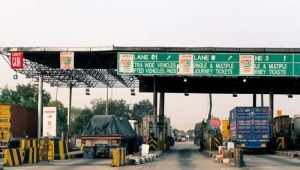 No matter how fast commuters could drive on the highway, they always got stuck while paying the toll. But now paying toll is made simpler than before and how?
No matter how fast commuters could drive on the highway, they always got stuck while paying the toll. But now paying toll is made simpler than before and how?
Tolling is a hot topic today because the toll collection has been a long-standing impediment in increasing the efficiency of vehicle movement. Consider this: before any of the modern electronic mechanisms came into play, India could waste 12 lakh litres fuel burn daily, 12 minutes of waiting time and 20 lakh man/ hours involved daily.
FASTag technology
To counter this impediment, the Government of India launched the National Electronic Toll Collection (NETC) program that introduced radio-frequency identification (RFID) based electronic toll collection in 2014. Branded as FASTag, this program was aimed at ensuring freeflow tolling across the entire National Highways (NH) network of the country. However, by March 2016, the FASTag program had failed to gain any traction. Only about 5,000 tags were in circulation 1.5 years after the launch.
However, with the strong support of the government institutions, including MoRTH, NHAI and IHMCL have ensured success of the program in the last 18 months. Today, 142 banks are live on UPI, compared with 21 banks when the payment system was launched three years ago. About 5.35 billion UPI-based transactions were recorded in FY 18-19 as compared to 915.2 million in FY 17-18. The total transactions of UPI jumped to 1.15 billion in October 2019 from 0.96 billion in September 2019. Similarly, the total transaction value of UPI stood at Rs 1.91 lakh crore in October 2019 compared to Rs 1.61 lakh crore in September 2019.
GPS-based tolling: Will it work?
Rusintelsys Pvt Ltd, which has bagged a pilot project to implement Global Navigation Satellite System (GNSS) in India told TrafficInfraTech about the rationale behind it. R Dervod, from Rusintelsys, explained, “Indian government’s main goal is to implement a technology which will ease the flow at toll plazas, reduce the investment in construction, reduce pollution, fuel consumption and transportation cost.” According to Dervod, the pilot project involves implementing a satellite based electronic toll collection system running on GPS/GSM technology for around 500 commercial vehicles on the Delhi Mumbai national highway. The project will run for one year. Working on a combination of mobile telecommunications technology (GSM) and GPS, the pilot tolling system would be able to deduct money from a vehicle account, credit the money to the concessionaire within one day and opens the toll gate. In case of a failed transaction, it would be able to alert the toll operator to collect payment manually and not open the gate. It will also draw a comparison between distance based tolling and the existing tolling system, as also virtual tolling Vs normal tolling.
Tech-Talk
 Other technologies used around the country is smart card with on boarded unit (OBUs). Countries like Singapore, Taiwan, Malaysia use OBUs which is installed in user’s car.
Other technologies used around the country is smart card with on boarded unit (OBUs). Countries like Singapore, Taiwan, Malaysia use OBUs which is installed in user’s car.
Through this, a user can use any smart card connected with OBUs to pay tolls. However, it costs Rs 10,000 per device whereas RFIDbased FASTag costs only Rs 100.
Another technology is automated number plate recognition (ANPR) which is widely used by many countries. Here the advantage according to Mandar Deshpande, Sr Product and Market Development Manager, NPCI is, one can link any payment account with that particular vehicle. However, in a country like India, it would not work as there are no standardization of number plates. Besides, the cost of operation of ANPR is high and need to install specific cameras to identify and process the transactions based on ANPR. Also, it requires database to enforce it to the correct vehicle owner.
Rahul Kamat
 TrafficInfraTech Magazine Linking People Places & Progress
TrafficInfraTech Magazine Linking People Places & Progress